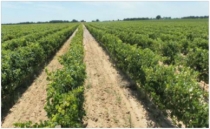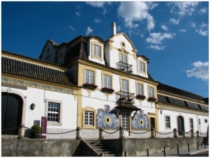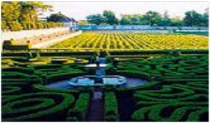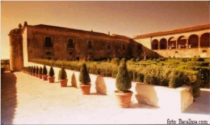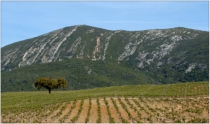Península de Setúbal
Wine region: PENÍNSULA DE SETÚBAL
“It was the Phoenicians and the Greeks who brought the grapevine varieties to this region from the Near East. Believing the climate amenable and the slopes of the Arrábida as well as the riparian zone of the Tagus to be propitious for the cultivation of the vine, they set to work with their planting. Later, the Romans and the Arabs did much to develop vine cultivation on this peninsula.” Wine exports began at the time of the foundation of the Kingdom of Portugal. At the end of the Middle Ages, royal warrants attested to the King’s interest in this wine. Azóia wine (from a port close to Setúbal) was a very well‑known brand on the English market. The Phoenician variety, Moscatel de Kelibia/Alexandria has gained international status under the label Moscatel de Setúbal. Lancers, the first great wine label to be distributed worldwide, has its origins in this region.
Situated on the west coast, south of Lisbon, this wine region has a terroir particularly well suited to the production of its famous and much‑appreciated liqueur wine. “This region can be divided into two completely distinct orographic zones: the one in the south and south‑east, is mountainous, formed by the Arrábida, Rosca and S. Luis mountain ranges and by the Palmela, S. Francisco and Azeitão mountains, all of which are interwoven with valleys and hills, at altitudes of between 100 and 500 metres; the other, by contrast, is flat, extending over a large plain along the river Sado. It has a mixed subtropical, Mediterranean climate. Influenced by the proximity of the sea, the river basins of the Tagus (Tejo) and Sado and by the mountain ranges and uplands of the region, the climate has little variation in temperature and annual rainfall of between 400 and 500 mm.” The soils are podsol‑granitic, sandy‑clay or loamy‑sandy‑clay, calcareous and slightly alkaline, mostly deep and with a low water retention capacity; some are compact and fertile.
The designated area covers a total of 9,210 hectares of vineyards, although roughly 2,075 hectares of this total is devoted to producing wine of DO quality. Most of the wine is exported. The region has large vitivinicultural companies which use advanced grape and wine processing technologies. The “Península de Setúbal” regional wine is produced throughout the District of Setúbal. There are two distinct DO wine regions: Setúbal, where fortified wine is produced; and Palmela, where white, red, rosé wines, semi‑sparkling and rosé sparkling wines and liqueur wines are produced.
The Comissão Vitivinícola Regional da Península de Setúbal (The Regional Vitivinicultural Commission of the Península de Setúbal), abbreviated to CVRPS, was officially approved as the certification authority mandated to regulate the production, trade and certification of vitivinicultural products entitled to bear the “Palmela” and “Setúbal” Designations of Origin (DO) and the geographical indication, “Península de Setúbal” IG.
(Quotations from IVV Yearbook)
Types of vitivinicultural products
Península de Setúbal IG wines or Península de Setúbal regional wines: White, red, rosé, semi‑sparkling: sparkling base wine, liqueur wine
Setúbal DO wines: Liqueur, white, red
Palmela DO wines: White, red, rosé, semi‑sparkling: sparkling base wine, liqueur wine
Regional Contacts
Technical information: COMISSÃO VITIVINÍCOLA REGIONAL DA PENINSULA DE SETÚBAL (“REGIONAL VITIVINICULTURAL COMMISSION OF THE SETÚBAL PENINSULA”); Rua Padre Manuel Gaetano nº 26; Tel 212337100, Website www.cvr‑psetubal.com
Cultural information on the wine of the region: Confraria dos amigos da Bacalhôa Vinhos Portugal (“Society of Friends of Bacalhôa Wines, Portugal”) , Website: www.bacalhoa.com; Confraria do Periquita, Website: www.JMF.pt
Confraria Muscatel de Setubal. (“Muscatel de Setúbal Society”)
Certification authority: COMISSÃO VITIVINÍCOLA REGIONAL DA PENÍNSULA DE SETÚBAL (“REGIONAL VITIVINICULTURAL COMMISSION OF THE SETÚBAL PENINSULA”) Rua Padre Manuel Caetano, 26; 2950‑253 PALMELA – Tel.: 212 337 100, Fax: 212 337 108 – Website: www.cvr‑psetubal.com, e‑mail: geral@cvr‑psetubal.com
Eno‑tourism information: Península de Setúbal Wine Route/Rota dos vinhos da Península de Setúbal, Costa Azul; Casa Mãe da Rota dos Vinhos, Largo de São João, 2950‑000 Palmela, Tel 212 334 990; Website: www.rotavinhospsetubal.com

Producer and bottler information on wine from the Lisboa region http://www.ivv.min‑agricultura.pt/np4/1736.html, → Yearbook 2011, pages 225‑226.
Designations: IGP “Península de Setúbal” Regional wine

DOP varieties in bold
RED WINES: Alfrocheiro, Alicante‑Bouschet, Alvarelhão, Alvarelhão‑Ceitão, Amaral, Amor‑Não‑Me‑Deixes, Amostrinha, Aragonez (Tinta‑Roriz), Aramon, Arjunção, Baga, Barca, Barreto, Bastardo, Bastardo‑Tinto, Bonvedro, Borraçal, Bragão, Branjo, Cabernet‑Franc, Cabernet‑Sauvignon, Caladoc, Calrão, Camarate, Carignan, Carrega‑Burros, Carrega‑Tinto, Casculho, Castelã, Castelão (Periquita), Castelino, Casteloa, Cidadelhe, Cidreiro, Cinsaut, Concieira, Coração‑de‑Galo, Cornifesto, Corropio, Corvo, Doçal, Doce, Donzelinho‑Tinto, Engomada, Esgana‑Cão‑Tinto, Espadeiro, Espadeiro‑Mole, Farinheira, Ferral, Galego, Gamay, Gonçalo‑Pires, Gorda, Gouveio‑Preto, Graciosa, Grand‑Noir, Grangeal, Grenache, Grossa, Jaen, Labrusco, Lourela, Malandra, Malvarisco, Malvasia‑Preta, Manteúdo‑Preto, Mário‑Feld, Marufo, Melhorio, Melra, Merlot, Molar, Mondet, Monvedro, Moreto, Moscatel‑Galego‑Tinto, Mourisco, Mourisco‑de‑Semente, Mourisco‑de‑Trevões, Negra‑Mole, Nevoeira, Padeiro, Parreira‑Matias, Patorra, Pau‑Ferro, Pedral, Pêro‑Pinhão, Petit‑Bouschet, Petit‑Verdot, Pexem, Pical, Pilongo, Pinot‑Noir, Português‑Azul, Preto‑Cardana, Preto‑Martinho, Rabo‑de‑Anho, Rabo‑de‑Lobo, Rabo‑de‑Ovelha‑Tinto, Ramisco, Ramisco‑Tinto, Ricoca, Rodo, Roseira, Rufete, Saborinho, Santareno, São‑Saul, Sevilhão, Sousão, Syrah, Tannat, Teinturier, Tinta, Tinta‑Aguiar, Tinta‑Aurélio, Tinta‑Barroca, Tinta‑Bastardinha, Tinta‑Caiada, Tinta‑Carvalha, Tinta‑Fontes, Tinta‑Francisca, Tinta‑Lameira, Tinta‑Lisboa, Tinta‑Martins, Tinta‑Mesquita, Tinta‑Miúda, Tinta‑Negra, Tinta‑Penajoia, Tinta‑Pereira, Tinta‑Pomar, Tinta‑Porto‑Santo, Tinta‑Tabuaço, Tintinha, Tinto‑Cão, Tinto‑Sem‑Nome, Touriga‑Fêmea, Touriga‑Franca, Touriga‑Nacional, Transâncora, Trincadeira (Tinta‑Amarela), Valdosa, Varejoa, Verdelho‑Tinto, Verdial‑Tinto, Vinhão, Xara, Zé‑do‑Telheiro, Zinfandel, (Moscatel‑Galego‑Roxo (R))
WHITE WINES: Alicante‑Branco, Almafra, Almenhaca, Alvadurão, Alvar, Alvarelhão‑Branco, Alvarinho, Antão Vaz, Arinto (Pedernã), Arinto‑do‑Interior, Arns‑Burguer, Avesso, Azal, Babosa, Barcelo, Bastardo‑Branco, Batoca, Beba, Bical, Boal‑Barreiro, Boal‑Branco, Boal‑Espinho, Branco‑Desconhecido, Branco‑Especial, Branco‑Gouvães, Branco‑Guimarães, Branco‑João, Branda, Budelho, Cainho, Caracol, Caramela, Carão‑de‑Moça, Carrasquenho, Carrega‑Branco, Cascal, Castelão‑Branco, Castelo‑Branco, Cerceal‑Branco, Cercial, Chardonnay, Chasselas, Chasselas‑Sabor, Chasselas‑Salsa, Chenin, Côdega‑de‑Larinho, Colombard, Cornichon, Corval, Crato‑Espanhol, Dedo‑de‑Dama, Diagalves, Dona‑Branca, Dona‑Joaquina, Donzelinho‑Branco, Dorinto, Encruzado, Esganinho, Esganoso, Estreito‑Macio, Fernão‑Pires (Maria Gomes), Folgasão, Folha‑de‑Figueira, Fonte‑Cal, Galego‑Dourado, Gigante, Godelho, Gouveio, Gouveio‑Estimado, Gouveio‑Real, Granho, Jacquere, Jampal, Lameiro, Larião, Leira, Lilás, Loureiro, Luzidio, Malvasia, Malvasia‑Bianca, Malvasia‑Branca, Malvasia‑Branca‑de‑São‑Jorge, Malvasia‑Cândida, Malvasia‑Fina, Malvasia‑Parda, Malvasia‑Rei, Malvasia‑Romana, Manteúdo, Molinha, Moscadet, Moscatel‑Galego‑Branco, Moscatel‑Graúdo, Moscatel‑Nunes, Mourisco‑Branco, Muller‑Thurgau, Pé‑Comprido, Perigo, Perrum, Pinheira‑Branca, Pinot‑Blanc, Pintosa, Praça, Promissão, Rabigato, Rabigato‑Franco, Rabigato‑Moreno, Rabo‑de‑Ovelha, Ratinho, Riesling, Roupeiro‑Branco, Sabro, Samarrinho, Santoal, São‑Mamede, Sarigo, Sauvignon, Semilão, Semillon, Sercial (Esgana‑Cão), Síria (Roupeiro), Tália, Tamarez, Terrantez, Terrantez‑da‑Terceira, Terrantez‑do‑Pico, Touriga‑Branca, Trajadura, Trincadeira – Branca, Trincadeira‑das‑Pratas, Uva‑Cão, Uva‑Cavaco, Uva‑Salsa, Valente, Valveirinho, Vencedor, Verdelho, Verdial‑Branco, Viognier, Viosinho and Vital.


